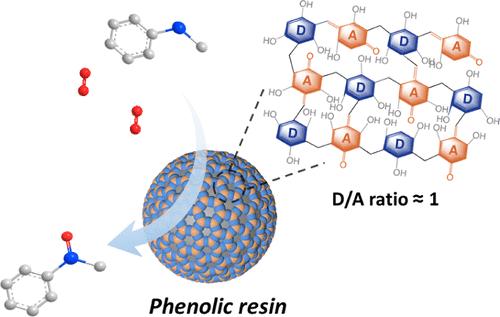当前位置:
X-MOL 学术
›
ACS Catal.
›
论文详情
Our official English website, www.x-mol.net, welcomes your
feedback! (Note: you will need to create a separate account there.)
Phenolic Resin with an Optimized Donor–Acceptor Architecture for Photocatalytic Aerobic Oxidation
ACS Catalysis ( IF 11.3 ) Pub Date : 2024-11-14 , DOI: 10.1021/acscatal.4c05023 Meng Li, Meirong Huang, Zheng Lin, Yidong Hou, Masakazu Anpo, Jimmy C. Yu, Jinshui Zhang, Xinchen Wang
ACS Catalysis ( IF 11.3 ) Pub Date : 2024-11-14 , DOI: 10.1021/acscatal.4c05023 Meng Li, Meirong Huang, Zheng Lin, Yidong Hou, Masakazu Anpo, Jimmy C. Yu, Jinshui Zhang, Xinchen Wang

|
A promising strategy to enhance exciton dissociation and charge separation in phenolic-polymer-based photocatalysts is the generation and utilization of benzenoid–quinoid donor–acceptor (D–A) couples inside the phenolic resin frameworks. However, there are often more donors than acceptors in phenolic resin due to the sluggish kinetics of in situ oxidation of phenols to quinoid methides, leading to a mismatched D/A ratio. Herein, we report a well-cross-linked phenolic resin with a unity D/A ratio synthesized by using phloroglucinol as a building block for condensation with formaldehyde. The higher electron density on the aromatic ring not only facilitates the in situ oxidation of phloroglucinols to quinoid methides, forming equivalent D–A couples, but also lowers the energy barrier for the condensation reaction, resulting in a highly cross-linked framework with a well-developed π-conjugated electronic structure. The phloroglucinol-formaldehyde resin product demonstrates significantly improved photocatalytic performance in the selective oxidation of methyl phenyl sulfide and the oxidative coupling of benzylamine. Our approach shows the potential of photocatalytic phenolic resins for solar-induced chemical conversion.
中文翻译:

酚醛树脂,具有优化的供体-受体结构,用于光催化有氧氧化
在酚醛聚合物基光催化剂中增强激子解离和电荷分离的一种有前途的策略是在酚醛树脂框架内产生和利用苯类-喹类供体-受体 (D-A) 对。然而,由于酚类原位氧化成喹类金属化物的动力学缓慢,酚醛树脂中的供体通常多于受体,导致 D/A 比不匹配。在此,我们报道了一种交联良好的酚醛树脂,其合成了具有单位 D/A 比的酚醛树脂,该树脂是通过使用根皮葡萄糖作为与甲醛缩合的结构单元合成的。芳环上较高的电子密度不仅促进了间苯三酚原位氧化成喹类金属化物,形成等效的 D-A 对,而且还降低了缩合反应的能垒,从而产生具有发达π共轭电子结构的高度交联框架。间苯三酚-甲醛树脂产品在甲基苯硫醚的选择性氧化和苄胺的氧化偶联中表现出显著改善的光催化性能。我们的方法显示了光催化酚醛树脂在太阳能诱导化学转化方面的潜力。
更新日期:2024-11-15
中文翻译:

酚醛树脂,具有优化的供体-受体结构,用于光催化有氧氧化
在酚醛聚合物基光催化剂中增强激子解离和电荷分离的一种有前途的策略是在酚醛树脂框架内产生和利用苯类-喹类供体-受体 (D-A) 对。然而,由于酚类原位氧化成喹类金属化物的动力学缓慢,酚醛树脂中的供体通常多于受体,导致 D/A 比不匹配。在此,我们报道了一种交联良好的酚醛树脂,其合成了具有单位 D/A 比的酚醛树脂,该树脂是通过使用根皮葡萄糖作为与甲醛缩合的结构单元合成的。芳环上较高的电子密度不仅促进了间苯三酚原位氧化成喹类金属化物,形成等效的 D-A 对,而且还降低了缩合反应的能垒,从而产生具有发达π共轭电子结构的高度交联框架。间苯三酚-甲醛树脂产品在甲基苯硫醚的选择性氧化和苄胺的氧化偶联中表现出显著改善的光催化性能。我们的方法显示了光催化酚醛树脂在太阳能诱导化学转化方面的潜力。


















































 京公网安备 11010802027423号
京公网安备 11010802027423号